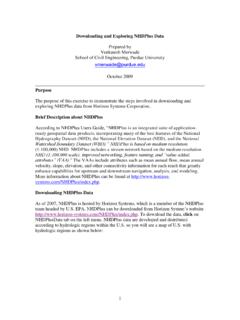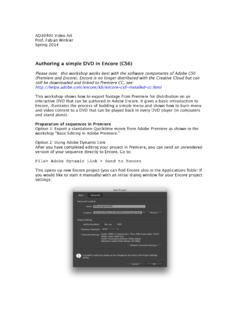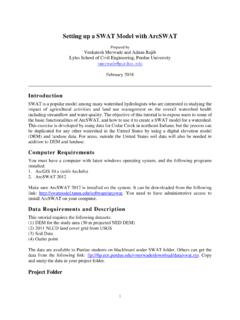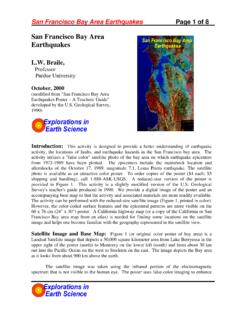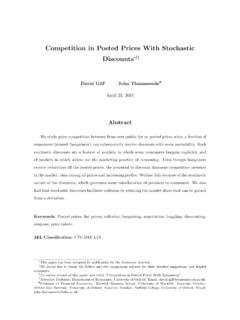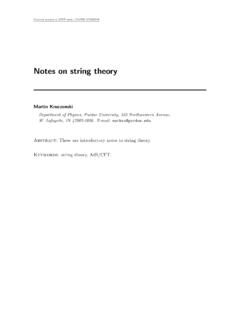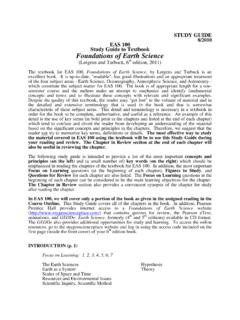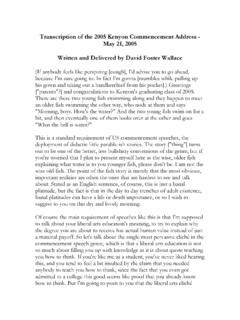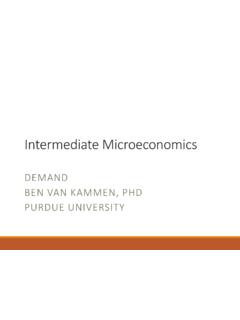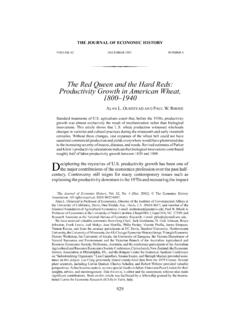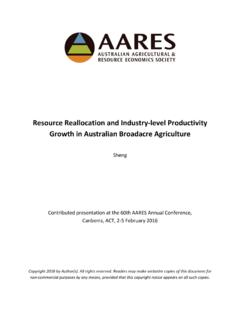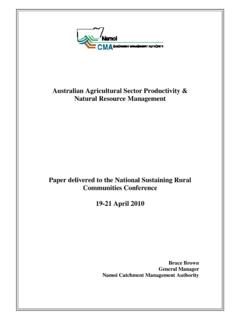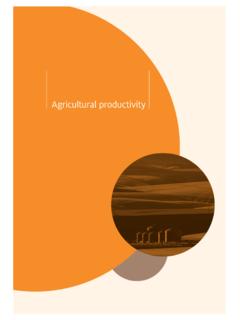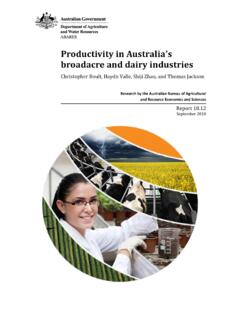Transcription of Global food security in 2050: the role of agricultural ...
1 Global food security in 2050: the role ofagricultural productivity and climate changeUris Lantz C. Baldos and Thomas W. Hertel In this paper, we examine how the complexities introduced by trends in agriculturalproductivity and climate change affect the future of Global food security . We use apartial equilibrium model of Global agriculture incorporating a food security modulethat links changes in the average dietary energy intake to shifts in the full caloricdistribution, allowing us to compute changes in the incidence, headcount and averagedepth of malnutrition.
2 After validating the model against an historical period, weimplement a series of future scenarios to understand the impacts of key exogenousdrivers on selected food security outcomes. Our results show improvements in globalfood security for the period 2006 2050. Despite growing population and increasedbiofuel demand, baseline income growth, coupled with projected increases inagricultural productivity lead to a 24 per cent rise in Global average dietary energyintake. Consequently, the incidence of malnutrition falls by 84 per cent, lifting morethan half a billion people out of extreme hunger.
3 However, these results hinge heavilyon agricultural productivity growth. Without such growth, there could be asubstantial setback on food security improvements. climate change adds uncertaintyto these projections, depending critically on the crop yield impacts of increasing CO2concentrations in the words: agricultural productivity , climate change , dietary energy, food security ,long-run IntroductionIn the coming decades, greaterper capitafood consumption is expected in thewake of growing incomes in the developing world. The resulting shifts inconsumption patterns from a diet high in starchy foods to one that is richer inprotein, including meats and dairy products (Gerbens-Leeneset ) willhave an important impact on Global agriculture.
4 Shifts in the types of foodsconsumed, from local towards Western foods, are also expected (Pingali2007). Coupled with steady population growth in the future, the competitionfor crop output between direct consumption, and livestock feedstuffs and rawinputs to processed food industries will intensify. At the same time, theindustrial demand for crops is expected to rise with the growing use ofrenewable fuels worldwide, especially for first generation biofuels whichrequire food crop feedstocks (Fischeret ).Over the past five decades, food availability has been greatly enhancedthrough productivity gains in the agricultural sector.
5 Continuation of such Uris Lantz C. Baldos (email: and Thomas W. Hertel are with theDepartment of agricultural Economics, Purdue University, West Lafayette, IN, USA. 2014 Australian agricultural and Resource Economics Society : Journal of agricultural and Resource Economics, 58, pp. 1 18 The Australian Journal ofJournal of the AustralianAgricultural and ResourceEconomics Societytrends will be critical to ensuring food security between now and mid-century,as population, incomes and biofuel use continue to grow. Total factorproductivity a measure of the growth in aggregate output relative to anindex of all inputs in both the Global crop and livestock sectors actually roseover the past two decades (Ludenaet ; Fuglie 2012).)
6 However, thereare concerns on some fronts that crop yields for key staple grains may bereaching their biophysical limits in some regions (Alstonet ). Thiscould have an adverse effect on Global food availability and prices. The futuretrajectory of crop yields will also be affected by climate change , although theprecise impacts are uncertain and spatially heterogeneous. Depending onlocation, the temperature and precipitation impacts of climate change maycause crop yields to rise or fall (Tubielloet ). There is also thepotential for crop yields to be enhanced via the fertilization effect of risingCO2concentrations in the atmosphere (Lobell and Field 2008).
7 In this paper, we examine how Global food security in 2050 will be affectedby the trends in agricultural productivity and the complexities introduced byclimate change . We add to the growing literature, which examines long-runglobal food security issues. These studies are based on a variety of methods,including: expert opinion coupled with trend analysis (Alexandratos andBruinsma 2012), integrated assessment models which heavily incorporatebiophysical processes (Fischeret ; Tubielloet ; Schneideret ) and partial as well as general equilibrium economic models(Msangiet ; Nelsonet , 2014; Golubet ).
8 However,most of these studies use limited metrics of food security , which onlyencompass average changes inper capitadietary energy consumption (DEC)in each region, whereas it is really thedistribution of caloric consumptionacross the population that is most critical for food security . In addition, thesestudies are largely based on models which have not been validated against thepast. By looking at the past prior to projecting into the future, we gaininsights into the changing relative importance of each major driver of globalfood security , as well as boosting confidence in the resultant light of the existing literature, this paper makes three , we quantify not only the prevalence of food insecurity given the driversof the Global farm and food system, but also the average depth of suchinsecurity, by accounting for the full distribution of dietary outcomes in eachworld region.
9 Second, we validate our food security module, looking back athistory to assess how well our model replicates observed changes in caloricmalnutrition outcomes. Third, we decompose historical and projected driversof food security which enables us to comment on changes in the relativeimportance of each major driver, with emphasis on the contribution ofagricultural productivity and climate change , as we move forward to rest of the paper is organized as follows. In section Model andmethods , we discuss the model of Global agriculture that we use to projectchanges in crop production and food consumption and introduce the foodsecurity module that we have developed to extrapolate nutritional outcomes 2014 Australian agricultural and Resource Economics Society Baldos and Hertelfrom the changes in average food consumption.
10 In section Historicalvalidation and Experimental design for future projections , we outline theexperiments. To evaluate the model and see how well it predicts food securitymetrics, we look back at the historical period 1991 to 2001 (section Historical validation ). We then examine the future, projecting forwardfrom 2006 to 2050 (section Experimental design for future projections ). Weimplement a sequence of scenarios that are designed to help us understand theimplications of agricultural demand and supply drivers on future nutritionaloutcomes.
